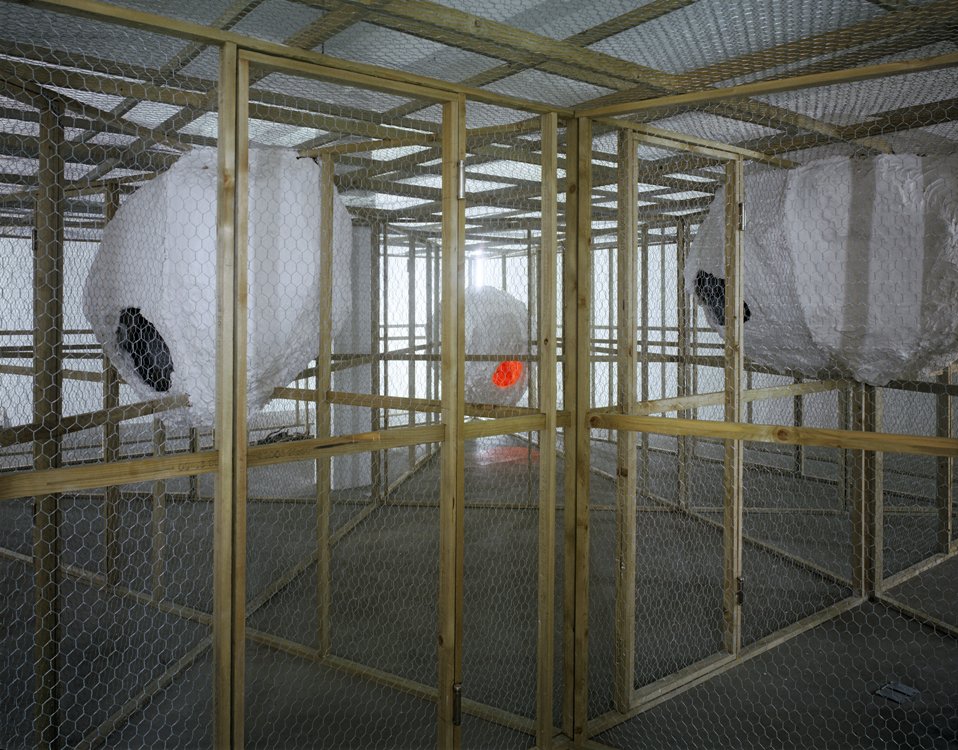Eclipse: Art in a Dark Age
Reviewed by Sara Walker
Mike Nelson, Amnesiac Shrine or Double Coop Displacement, 2006–08, installation, 910 × 910 × 225 cm. Moderna Museet, Stockholm. Gift from the Friends of Moderna Museet. Courtesy of Matt´s gallery, London, and Galleria Franco Noero, Torino.
‘To be “wrong” in relation to one’s own era — to break against consensus — can involve formulating a new position that will prove to be crucial to the future. To be wrong and to refuse to the cut-and-dried positions of the prevailing discussion can be a conscious strategy and a form of resistance. It is also an approach that creates greater potential for more interesting and less predictable art. This approach is what unites the artists in Eclipse: Art in a Dark Age. They also share the ability to use the freedom to speculate which fiction affords, and a fascination for the dark side.’
— Magnus af Petersens, from the catalogue text Twilight Vision.
Where does this leave me? And what exactly is the ‘prevailing discussion’ these artists are said to be refusing? Is the vagueness of the curatorial idea doing the exhibition any harm, or does it provide a certain sense of freedom? The curatorial physical idea is explicit, seeing that it is hard to ignore the overall colour scheme and carpeted floor. Is the idea of an eclipse strong enough to use regarding the participating, or should that be the chosen, artists? I find the word ‘participating’ problematic due to the fact that the art works doesn’t seem to be doing much participation. They are simply being displayed within the curatorial framework; a framework so vast that it seems almost indiscriminate as to which artist was to be included in Eclipse. This leaves me with the feeling of seeing art works very much isolated from each other. Is this a relevant objection? The group exhibition as idea always fuels these sort of objections. Perhaps the curators themselves only strived for a linkage from each individual art work towards the idea of art in a dark age, and not a relation between the artworks themselves.
A quick glance at the exhibition suggests that some elements of something grotesque and somewhat surreal can be considered belonging to art in a dark age, Dana Schutz and Natalie Djurberg both have these elements in their work, albeit in very different styles and attitudes. The multitude of artistic expressions and the actual distance between them gives the feeling of isolated, small exhibitions within the group exhibition; the room being painted in a dark colour doesn’t change that feeling.
The curator Magnus af Petersens writes about the different aspects of Eclipse, one being that the political isn’t about art being explicitly political. The connotations that can be derived from the notion of art in a dark age are, for me, art that takes a look at our times, at our political reality — and the negativity that surrounds us, and that is, according to the curator, what can be found in this exhibition, but in a very subtle sense.
The paintings by Michaël Borremans and the collages by Ellen Gallagher can be said to contain certain amounts of a commentary of society, Borremans paintings seem to bear witness to past human experiments and Gallagher’s collages in the series De Luxe are made of old magazine ads that have been altered so that they display different racial stereotypes and attitudes. Anri Sala’s works are ambiguous; they are both incredibly poetic and contain a documentation of a derelict reality, as in Blindfold, 2002, where the façade of the building is crumbling. Paul McCarthy seems very much the odd one out in this exhibition, and that is somewhat curious in an exhibition this heterogeneous. Perhaps Nathalie Djurberg can be seen as a bridge between the more solemn works in the exhibition to Paul McCarthy’s always very hysterical and messy works? Nathalie Djurberg’s films are somewhere in-between the controlled and the wild.
What about Dana Schutz then? Do her paintings have anything to do with art in a dark age? To my joy the curatorial idea actually helps me to see her works as something in touch with our times, whereas before I have seen them in the light of a sort of nostalgia, or even pastiche. In this new context I see a commentary function within the grotesque motifs, as images that comments on the state of things. It is perhaps in this movement between curatorial idea and art work that this exhibition is best understood? Perhaps it is best not to try connecting the whole room into one unified exhibition. Within the confinement of the exhibition I, as a viewer, is forced to look upon these art works as having something to do with the idea of an eclipse and of darkness. Is it art’s version of help me help myself? This strategy backfires, as I am not entirely sure about the exhibition packaging.
Some of the works escape the exhibition even before it’s closing. Mike Nelson, for one. His work AMNESIAC SHRINE or Double Coop Displacement, 2006–08, already has its own secret room, and this spatial arrangement cements this notion of the work not really connecting to the rest of the exhibition. It makes its own space.
Some works show a great deal of clarity within their own space and this outshines the curatorial work. The two components of a group exhibition; art works and curatorial ideas can make way for an interesting struggle, but unfortunately Eclipse: Art in a Dark Age doesn’t contain a struggle of that kind.
